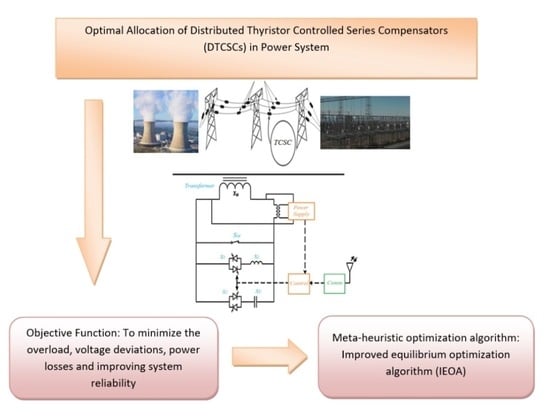Optimal Allocation of Distributed Thyristor Controlled Series Compensators in Power System Considering Overload, Voltage, and Losses with Reliability Effect
Abstract
1. Introduction
- Optimal multi-objective allocation of the DTCSC in the power system, considering overload, voltage deviations, and reliability;
- Evaluation of the system reliability based on energy not-supplied due to line outage;
- Using a new and improved equilibrium optimization algorithm to determine DTCSC allocation;
- Achieving zero overload and ENS;
- Superior performance of the IEOA compared with the traditional EOA, PSO, and MRFO methods.
2. Formulation of the Problem
2.1. Objective Functions
2.1.1. Overload Management
2.1.2. Voltage Deviation
2.1.3. Loss Reduction
2.1.4. Reliability Improvement
2.2. Multi-Objective Optimization of the Problem
2.3. Constraints
3. Proposed Optimization Approach
3.1. Introduction of EOA
3.1.1. Initializing and Calculating the Fitness
3.1.2. Balance Pool (Ceq)
3.1.3. Exponential Expression (F)
3.1.4. Production Rate (G)
3.1.5. Particle Memory Storage
3.2. Overview of IEOA
3.3. IEOA Implementation
4. Simulation Results and Discussion
4.1. Results of 14-Bus System
4.1.1. Results of the First Scenario (Outage of Line One)
4.1.2. Results of the Second Scenario (Outage of Line Two)
4.1.3. Results of the Third Scenario (Outage of Line 10)
4.2. Results of the 118-Bus System
4.3. The Effect of Considering Reliability
4.4. Effect of Load Demand Variations
4.5. Effect of DTCSC Reactance Minimization (RM)
4.6. Comparison with Previous Studies
5. Conclusions
Author Contributions
Funding
Data Availability Statement
Conflicts of Interest
References
- Farooq, Z.; Rahman, A.; Lone, S.A. Power generation control of restructured hybrid power system with FACTS and energy storage devices using optimal cascaded fractional-order controller. Optim. Control. Appl. Methods 2022, 43, 757–786. [Google Scholar] [CrossRef]
- Shakarami, M.R.; Davoudkhani, I.F. Wide-area power system stabilizer design based on grey wolf optimization algorithm considering the time delay. Electr. Power Syst. Res. 2016, 133, 149–159. [Google Scholar] [CrossRef]
- Kang, T.; Yao, J.; Duong, T.; Yang, S.; Zhu, X. A hybrid approach for power system security enhancement via optimal installation of flexible AC transmission system (FACTS) devices. Energies 2017, 10, 1305. [Google Scholar] [CrossRef]
- Khan, B.; Redae, K.; Gidey, E.; Mahela, O.P.; Taha, I.B.; Hussien, M.G. Optimal integration of DSTATCOM using improved bacterial search algorithm for distribution network optimization. Alex. Eng. J. 2022, 61, 5539–5555. [Google Scholar] [CrossRef]
- Jordehi, A.R.; Jasni, J.; Abd Wahab, N.; Kadir, M.Z.; Javadi, M.S. Enhanced leader PSO (ELPSO): A new algorithm for allocating distributed TCSC’s in power systems. Int. J. Electr. Power Energy Syst. 2015, 64, 771–784. [Google Scholar] [CrossRef]
- Ahmed, E.M.; Rakočević, S.; Ćalasan, M.; Ali, Z.M.; Hasanien, H.M.; Turky, R.A.; Aleem, S.H.A. BONMIN solver-based coordination of distributed FACTS compensators and distributed generation units in modern distribution networks. Ain Shams Eng. J. 2022, 13, 101664. [Google Scholar] [CrossRef]
- Wei, Z.; Shi, Y.; Ma, D.; Liu, G. Modified Particle Swarm Optimization algorithm by enhancing search ability of global optimal particle. In Proceedings of the 2015 12th IEEE International Conference on Electronic Measurement & Instruments (ICE-MI), Qingdao, China, 16–18 July 2015; pp. 451–457. [Google Scholar] [CrossRef]
- Ambriz-Perez, H.; Acha, E.; Fuerte-Esquivel, C.R. TCSC-firing angle model for optimal power flow solutions using Newton’s method. Int. J. Electr. Power Energy Syst. 2006, 28, 77–85. [Google Scholar] [CrossRef]
- Kazemi, A.; Badrzadeh, B. Modeling and simulation of SVC and TCSC to study their limits on maximum loadability point. Int. J. Electr. Power Energy Syst. 2004, 26, 619–626. [Google Scholar] [CrossRef]
- Vyas, B.Y.; Maheshwari, R.P.; Das, B. Improved fault analysis technique for protection of Thyristor controlled series compensated transmission line. Int. J. Electr. Power Energy Syst. 2014, 55, 321–330. [Google Scholar] [CrossRef]
- Jordehi, A.R. Brainstorm optimisation algorithm (BSOA): An efficient algorithm for finding optimal location and setting of FACTS devices in electric power systems. Int. J. Electr. Power Energy Syst. 2015, 69, 48–57. [Google Scholar] [CrossRef]
- Khan, A.N.; Imran, K.; Nadeem, M.; Pal, A.; Khattak, A.; Ullah, K.; Younas, M.W.; Younis, M.S. Ensuring reliable operation of electricity grid by placement of FACTS devices for developing countries. Energies 2021, 14, 2283. [Google Scholar] [CrossRef]
- Nadeem, M.; Imran, K.; Khattak, A.; Ulasyar, A.; Pal, A.; Zeb, M.Z.; Khan, A.N.; Padhee, M. Optimal placement, sizing and coordination of FACTS devices in transmission network using whale optimization algorithm. Energies 2020, 13, 753. [Google Scholar] [CrossRef]
- Tashakkori, A.; Abu-Siada, A.; Wolfs, P.J.; Islam, S. Optimal Placement of Synchronized Voltage Traveling Wave Sensors in a Radial Distribution Network. IEEE Access 2021, 9, 65380–65387. [Google Scholar] [CrossRef]
- Dash, S.K.; Mishra, S.; Abdelaziz, A.Y.; Hong, J.; Geem, Z.W. Optimal Planning of Multitype DGs and D-STATCOMs in Power Distribution Network Using an Efficient Parameter Free Metaheuristic Algorithm. Energies 2022, 15, 3433. [Google Scholar] [CrossRef]
- Tuzikova, V.; Tlusty, J.; Muller, Z. A novel power losses reduction method based on a particle swarm optimization algorithm using STATCOM. Energies 2018, 11, 2851. [Google Scholar] [CrossRef]
- Devi, S.; Geethanjali, M. Optimal location and sizing determination of Distributed Generation and DSTATCOM using Particle Swarm Optimization algorithm. Int. J. Electr. Power Energy Syst. 2014, 62, 562–570. [Google Scholar] [CrossRef]
- Fadel, W.; Kilic, U.; Taskin, S. Placement of Dg, Cb, and Tcsc in radial distribution system for power loss minimi-zation using back-tracking search algorithm. Electr. Eng. 2017, 99, 791–802. [Google Scholar] [CrossRef]
- Pereira, J.S.; Belati, E.A.; do Nascimento, C.F.; Silva, P.F.; Rossoni, P. A Mathematical Programming Approach for Allocation and Analysis of TCSC in Power Transmission Systems. IEEE Lat. Am. Trans. 2021, 20, 2001–2009. [Google Scholar] [CrossRef]
- Shiva, C.K.; Badi, M.; Babu, R.; Mahapatra, S.; Vedik, B.; Rangarajan, S.S. Thyristor controlled series compensator for the solution of reactive power management problem. AIP Conf. Proc. 2022, 2418, 040002. [Google Scholar]
- Faramarzi, A.; Heidarinejad, M.; Stephens, B.; Mirjalili, S. Equilibrium optimizer: A novel optimization algorithm. Knowl. -Based Syst. 2020, 191, 105190. [Google Scholar] [CrossRef]
- Kennedy, J.; Eberhart, R. Particle swarm optimization. Proceedings of ICNN’95—International Conference on Neural Networks, Perth, WA, Australia, 27 November–1 December 1995; Volume 4, pp. 1942–1948. [Google Scholar]
- Zhao, W.; Zhang, Z.; Wang, L. Manta ray foraging optimization: An effective bio-inspired optimizer for engineering applications. Eng. Appl. Artif. Intell. 2020, 87, 103300. [Google Scholar] [CrossRef]
- Naderipour, A.; Abdul-Malek, Z.; Nowdeh, S.A.; Ramachandaramurthy, V.K.; Kalam, A.; Guerrero, J.M. Optimal allocation for combined heat and power system with respect to maximum allowable capacity for reduced losses and improved voltage profile and reliability of microgrids considering loading condition. Energy 2020, 196, 117124. [Google Scholar] [CrossRef]
- Nowdeh, S.A.; Davoudkhani, I.F.; Moghaddam, M.H.; Najmi, E.S.; Abdelaziz, A.Y.; Ahmadi, A.; Razavi, S.E.; Gandoman, F.H. Fuzzy multi-objective placement of renewable energy sources in distribution system with objective of loss reduction and reliability improvement using a novel hybrid method. Appl. Soft Comput. 2019, 77, 761–779. [Google Scholar] [CrossRef]
- Sun, H.; Ebadi, A.G.; Toughani, M.; Nowdeh, S.A.; Naderipour, A.; Abdullah, A. Designing framework of hybrid photovoltaic-biowaste energy system with hydrogen storage considering economic and technical indices using whale optimization algorithm. Energy 2022, 238, 121555. [Google Scholar] [CrossRef]
- Jafar-Nowdeh, A.; Babanezhad, M.; Arabi-Nowdeh, S.; Naderipour, A.; Kamyab, H.; Abdul-Malek, Z.; Ramachandaramurthy, V.K. Meta-heuristic matrix moth–flame algorithm for optimal reconfiguration of distribution networks and placement of solar and wind renewable sources considering reliability. Environ. Technol. Innov. 2020, 20, 101118. [Google Scholar] [CrossRef]
- Hadidian-Moghaddam, M.J.; Arabi-Nowdeh, S.; Bigdeli, M.; Azizian, D. A multi-objective optimal sizing and siting of distributed generation using ant lion optimization technique. Ain Shams Eng. J. 2018, 9, 2101–2109. [Google Scholar] [CrossRef]
- Naderipour, A.; Nowdeh, S.A.; Saftjani, P.B.; Abdul-Malek, Z.; Mustafa, M.W.B.; Kamyab, H.; Davoudkhani, I.F. Deterministic and probabilistic multi-objective placement and sizing of wind renewable energy sources using improved spotted hyena optimizer. J. Clean. Prod. 2021, 286, 124941. [Google Scholar] [CrossRef]
- Naderipour, A.; Abdullah, A.; Marzbali, M.H.; Nowdeh, S.A. An improved corona-virus herd immunity optimizer algorithm for network reconfiguration based on fuzzy multi-criteria approach. Expert Syst. Appl. 2022, 187, 115914. [Google Scholar] [CrossRef]
- Jahannoush, M.; Nowdeh, S.A. Optimal designing and management of a stand-alone hybrid energy system using meta-heuristic improved sine–cosine algorithm for Recreational Center, case study for Iran country. Appl. Soft Comput. 2020, 96, 106611. [Google Scholar] [CrossRef]
- Christie, R. Power Systems Test Case Archive; Electrical Engineering Dept., University of Washington: Washington, DC, USA, 2000; Volume 108. [Google Scholar]

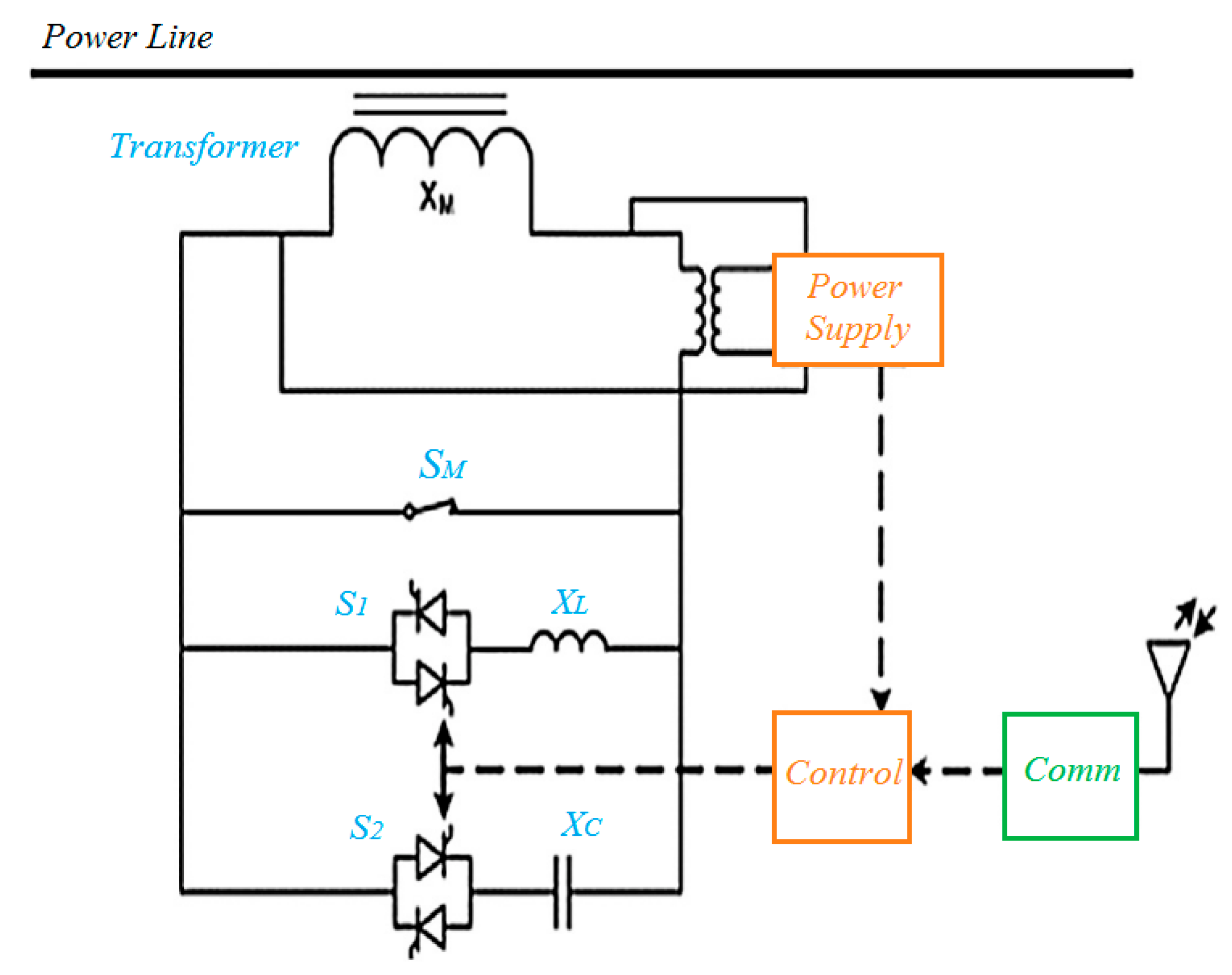
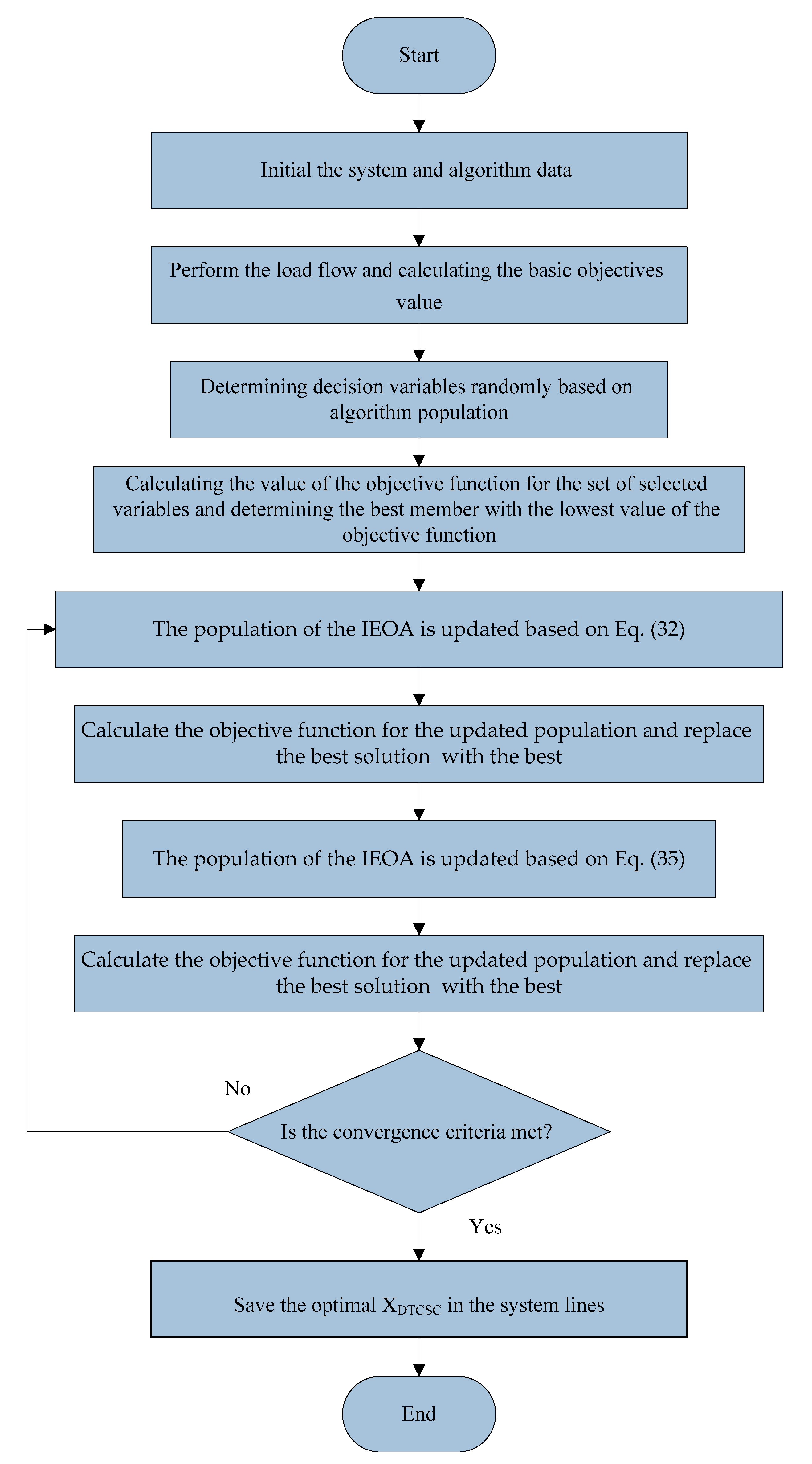



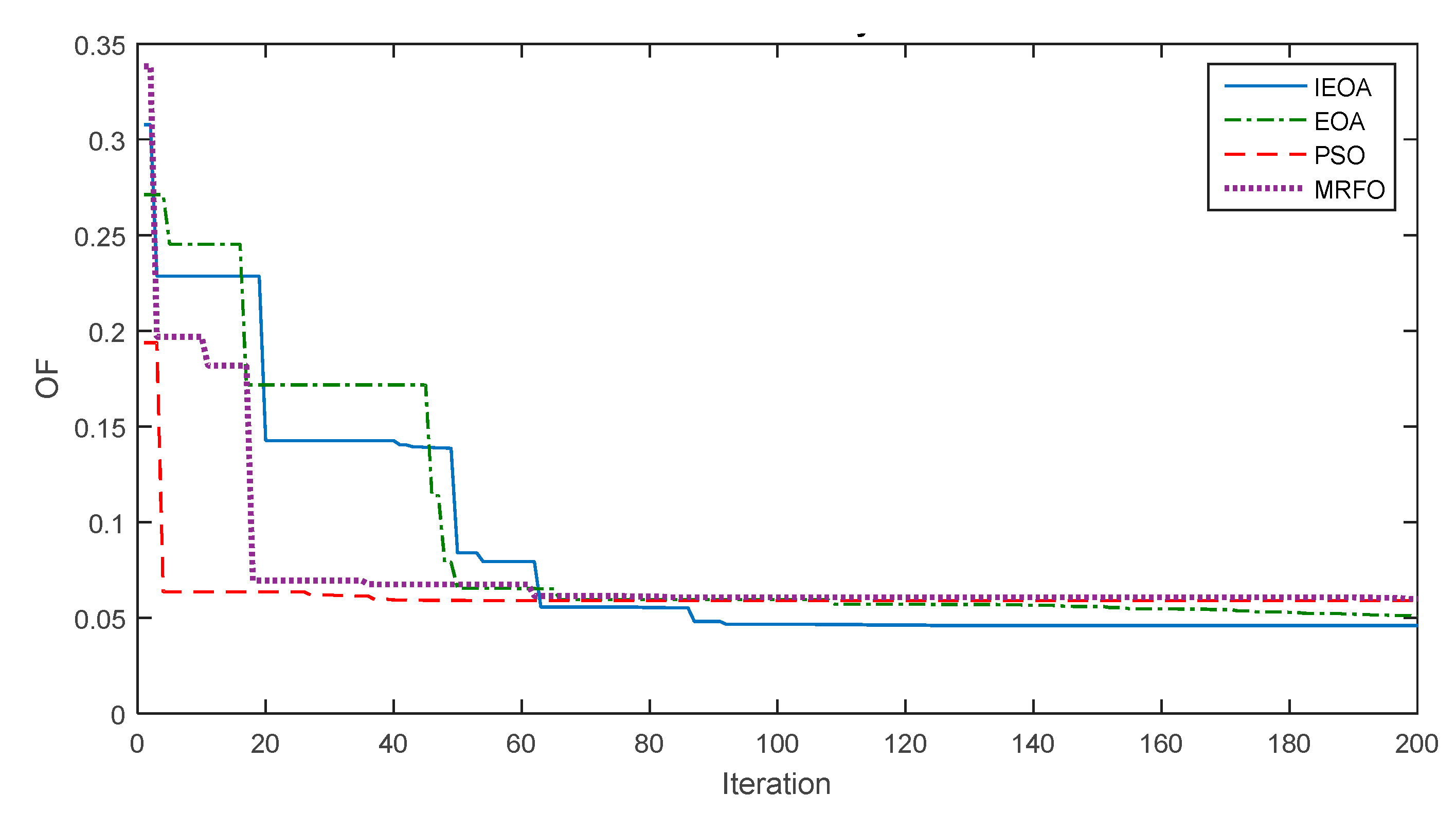

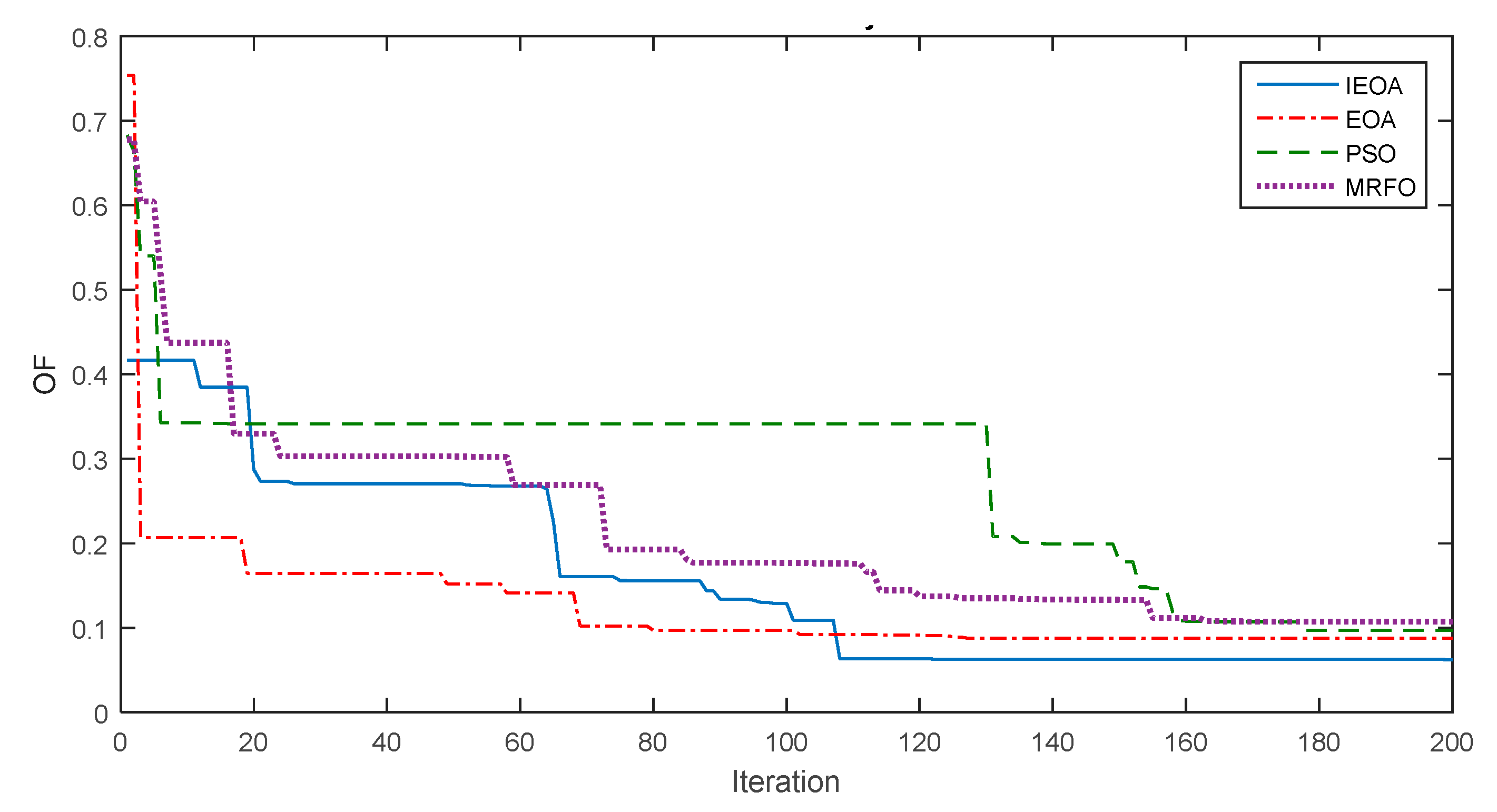


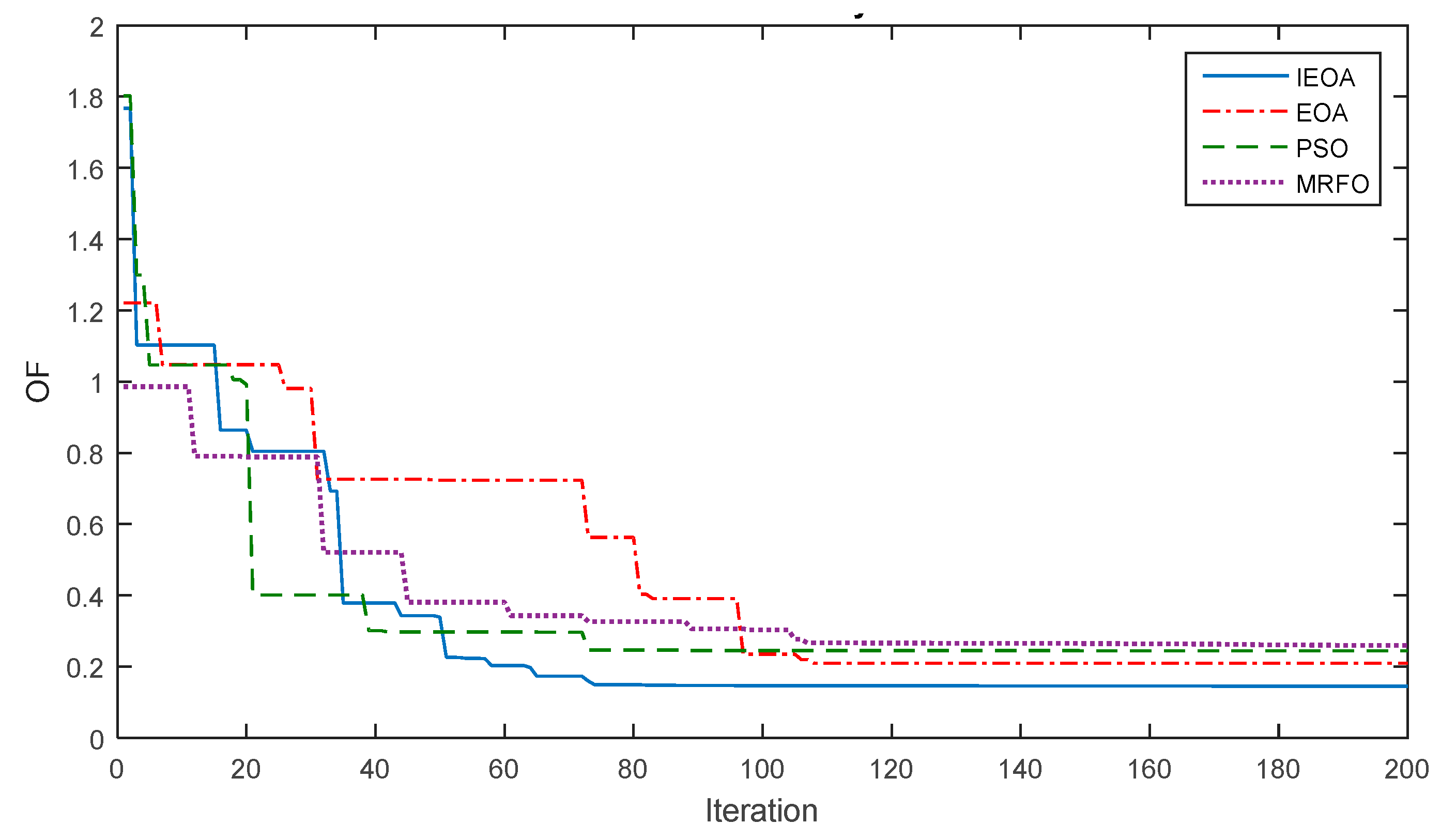
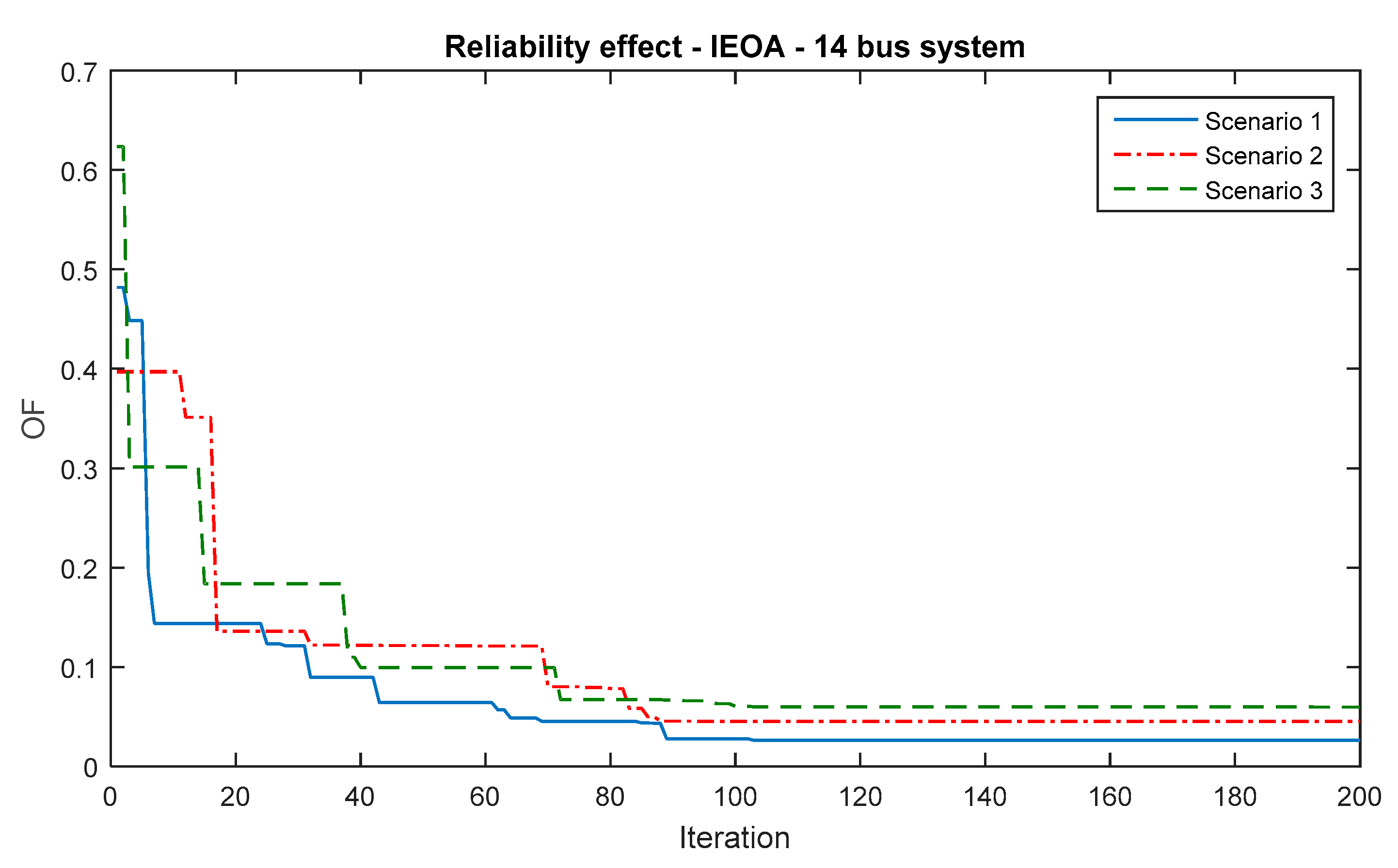
| Algorithm/Parameter | Variable Number | Variables Limit | Population Number | Maximum Iteration | Repetition Number |
|---|---|---|---|---|---|
| IEOA | System Lines | 100 | 200 | 20 | |
| EOA | System Lines | 100 | 200 | 20 | |
| PSO | System Lines | 100 | 200 | 20 | |
| MRFO | System Lines | 100 | 200 | 20 |
| Scenario | Line Outage | Sending Bus | Ending Bus |
|---|---|---|---|
| 1 | 1 | 1 | 2 |
| 2 | 2 | 1 | 5 |
| 3 | 10 | 5 | 6 |
| Tem | Value |
|---|---|
| Ploss (MW) | 13.39 |
| DEV | 0.0349 |
| OL | 55.84 |
| OF/Method | IEOA | EOA | PSO | MRFO |
|---|---|---|---|---|
| Mean | 0.0401 | 0.0443 | 0.0451 | 0.0538 |
| Std | 0.018 | 0.02 | 0.022 | 0.028 |
| Best | 0.032 | 0.0429 | 0.0437 | 0.0529 |
| Worst | 0.0431 | 0.0478 | 0.0482 | 0.0551 |
| OF/Method | Base System | IEOA | EOA | PSO | MRFO |
|---|---|---|---|---|---|
| OL | 2.1555 | 0 | 0.0069 | 0.0263 | 0.0433 |
| DEV | 0.0252 | 0.0021 | 0.0021 | 0.0024 | 0.0022 |
| Ploss (MW) | 0.4197 | 0.0148 | 0.0341 | 0.019 | 0.0331 |
| OF1 | - | 0 | 0.0032 | 0.0122 | 0.0201 |
| OF2 | - | 0.0832 | 0.0843 | 0.0953 | 0.0902 |
| OF3 | - | 0.0352 | 0.0814 | 0.0453 | 0.0789 |
| OF | 1 | 0.032 | 0.0429 | 0.0437 | 0.0529 |
| OF/Method | IEOA | EOA | PSO | MRFO |
|---|---|---|---|---|
| Mean | 0.0517 | 0.0546 | 0.0596 | 0.0573 |
| Std | 0.029 | 0.027 | 0.032 | 0.037 |
| Best | 0.0458 | 0.0505 | 0.0588 | 0.0597 |
| Worst | 0.0537 | 0.0562 | 0.0626 | 0.0541 |
| OF/Method | Base System | IEOA | EOA | PSO | MRFO |
|---|---|---|---|---|---|
| OL | 2.1555 | 0 | 0 | 0 | 0 |
| DEV | 0.0252 | 0.0021 | 0.0022 | 0.0032 | 0.0021 |
| Ploss (MW) | 0.4197 | 0.0245 | 0.0285 | 0.0258 | 0.0398 |
| OF1 | - | 0 | 0 | 0 | 0 |
| OF2 | - | 0.0748 | 0.078 | 0.114 | 0.0728 |
| OF3 | - | 0.1171 | 0.1357 | 0.1229 | 0.1859 |
| OF | 1 | 0.0458 | 0.0505 | 0.0588 | 0.0597 |
| OF/Method | IEOA | EOA | PSO | MRFO |
|---|---|---|---|---|
| Mean | 0.0659 | 0.0886 | 0.0983 | 0.1087 |
| Std | 0.032 | 0.028 | 0.035 | 0.038 |
| Best | 0.0624 | 0.0875 | 0.0971 | 0.1076 |
| Worst | 0.0784 | 0.0892 | 0.1048 | 0.1102 |
| OF/Method | Base System | IEOA | EOA | PSO | MRFO |
|---|---|---|---|---|---|
| OL | 2.1555 | 0 | 0 | 0.0617 | 0.0764 |
| DEV | 0.0252 | 0.0021 | 0.0038 | 0.0022 | 0.0022 |
| Ploss (MW) | 0.4197 | 0.0379 | 0.0478 | 0.0359 | 0.0377 |
| OF1 | - | 0 | 0 | 0.0728 | 0.0971 |
| OF2 | - | 0.0564 | 0.1001 | 0.0587 | 0.0573 |
| OF3 | - | 0.2274 | 0.2877 | 0.2155 | 0.2266 |
| OF | 1 | 0.0624 | 0.0875 | 0.0971 | 0.1076 |
| Algorithm/Parameter | Variable Number | Variables Limit | Population Number | Maximum Iteration | Repetition Number |
|---|---|---|---|---|---|
| IEOA | System Lines | 1000 | 200 | 20 | |
| EOA | System Lines | 1000 | 200 | 20 | |
| PSO | System Lines | 1000 | 200 | 20 | |
| MRFO | System Lines | 1000 | 200 | 20 |
| OF/Scenario | Base System | Outage of Line Nine |
|---|---|---|
| Ploss (MW) | 1.3286 | 2.0557 |
| DEV | 0.0087 | 0.0126 |
| OL | 0 | 0.7846 |
| OF/Method | IEOA | EOA | PSO | MRFO |
|---|---|---|---|---|
| Mean | 0.0659 | 0.0886 | 0.0983 | 0.1087 |
| Std | 0.032 | 0.028 | 0.035 | 0.038 |
| Best | 0.1448 | 0.2088 | 0.2437 | 0.2592 |
| Worst | 0.0784 | 0.0892 | 0.1048 | 0.1102 |
| Objective Function | Base System | IEOA | EOA | PSO | MRFO |
|---|---|---|---|---|---|
| OL | 0.7846 | 0.0387 | 0.0216 | 0 | 0.0449 |
| DEV | 0.0126 | 0.0041 | 0.0049 | 0.0032 | 0.0055 |
| Ploss (MW) | 2.0557 | 0.2326 | 0.8065 | 1.7222 | 1.0251 |
| OF1 | - | 0.0493 | 0.0275 | 0 | 0.0572 |
| OF2 | - | 0.3254 | 0.3888 | 0.2539 | 0.4365 |
| OF3 | - | 0.1113 | 0.3923 | 0.8377 | 0.4986 |
| OF | 1 | 0.1448 | 0.2088 | 0.2437 | 0.2592 |
| Branch | XDTCSC | Branch | XDTCSC | Branch | XDTCSC | Branch | XDTCSC |
|---|---|---|---|---|---|---|---|
| 1 | −0.0409 | 48 | −0.1578 | 95 | −0.0059 | 142 | 0.0362 |
| 2 | 0.06081 | 49 | −0.0323 | 96 | −0.1326 | 143 | −0.1369 |
| 3 | 0.01022 | 50 | 0.00285 | 97 | −0.0588 | 144 | 0.04021 |
| 4 | 0.08757 | 51 | 0.02402 | 98 | 0.04087 | 145 | −0.0942 |
| 5 | 0.05599 | 52 | 0.21074 | 99 | −0.0372 | 146 | −0.135 |
| 6 | −0.0325 | 53 | 0.20872 | 100 | 0.29028 | 147 | −0.0314 |
| 7 | 0.00285 | 54 | −0.1017 | 101 | −0.0585 | 148 | 0.3237 |
| 8 | −0.0129 | 55 | −0.0187 | 102 | 0.00425 | 149 | −0.0427 |
| 9 | −0.0201 | 56 | −0.0276 | 103 | 0.17284 | 150 | 0.13505 |
| 10 | 0.00461 | 57 | −0.0026 | 104 | 0.00368 | 151 | 0.08896 |
| 11 | 0.136 | 58 | −0.0126 | 105 | −0.2023 | 152 | −0.1877 |
| 12 | 0.02225 | 59 | 0.33347 | 106 | −0.0781 | 153 | 0.00196 |
| 13 | 0.00768 | 60 | −0.2914 | 107 | −0.0271 | 154 | 0.11603 |
| 14 | 0.25069 | 61 | 0.12221 | 108 | −0.0012 | 155 | −0.0072 |
| 15 | −0.0296 | 62 | 0.19492 | 109 | 0.29777 | 156 | 0.10101 |
| 16 | −0.0977 | 63 | 0.24846 | 110 | 0.06551 | 157 | 0.15156 |
| 17 | 0.12479 | 64 | 0.09243 | 111 | −0.1118 | 158 | −0.006 |
| 18 | 0.0558 | 65 | −0.0027 | 112 | −0.0382 | 159 | 0.09702 |
| 19 | 0.28409 | 66 | 0.15141 | 113 | 0.04494 | 160 | 0.16449 |
| 20 | 0.16266 | 67 | 0.39759 | 114 | 0.10479 | 161 | 0.07149 |
| 21 | −0.0247 | 68 | −0.0816 | 115 | −0.0766 | 162 | −0.2113 |
| 22 | −0.2298 | 69 | −0.0161 | 116 | 0.13859 | 163 | 0.05529 |
| 23 | 0.03803 | 70 | 0.04364 | 117 | 0.03338 | 164 | 0.1502 |
| 24 | −0.0307 | 71 | 0.00927 | 118 | −0.0041 | 165 | −0.0653 |
| 25 | 0.22736 | 72 | −0.0867 | 119 | −0.0063 | 166 | 0.31964 |
| 26 | 0.02386 | 73 | 0.2186 | 120 | −0.0562 | 167 | 0.458 |
| 27 | 0.1362 | 74 | −0.1082 | 121 | 0.02288 | 168 | 0.01671 |
| 28 | −0.1238 | 75 | −0.1633 | 122 | 0.0155 | 169 | −0.0499 |
| 29 | −0.0688 | 76 | −0.3448 | 123 | −0.035 | 170 | 0.16234 |
| 30 | 0.00184 | 77 | 0.08263 | 124 | −0.1825 | 171 | −0.06 |
| 31 | 0.01152 | 78 | 0.0185 | 125 | 0.08603 | 172 | 0.28423 |
| 32 | 0.02321 | 79 | 0.02369 | 126 | 0.03244 | 173 | −0.0359 |
| 33 | −0.0929 | 80 | −0.0251 | 127 | −0.0695 | 174 | −0.2714 |
| 34 | 0.13048 | 81 | −0.1351 | 128 | −0.1313 | 175 | 0.05373 |
| 35 | 0.14286 | 82 | −0.1634 | 129 | 0.01859 | 176 | 0.11113 |
| 36 | −0.0166 | 83 | −0.133 | 130 | −0.0621 | 177 | 0.00536 |
| 37 | 0.04151 | 84 | 0.37442 | 131 | −0.0242 | 178 | 0.02964 |
| 38 | 0.11898 | 85 | 0.14479 | 132 | −0.0959 | 179 | −0.129 |
| 39 | 0.23832 | 86 | 0.07913 | 133 | −0.0281 | 180 | 0.02407 |
| 40 | 0.04366 | 87 | −0.1401 | 134 | 0.0052 | 181 | 0.11211 |
| 41 | −0.0722 | 88 | −0.0492 | 135 | 0.0961 | 182 | −0.0151 |
| 42 | −0.1223 | 89 | −0.009 | 136 | 0.18478 | 183 | 0.0047 |
| 43 | 0.08456 | 90 | 0.00715 | 137 | −0.1409 | 184 | −0.1099 |
| 44 | −0.1338 | 91 | 0.07332 | 138 | −0.1373 | 185 | −0.0212 |
| 45 | 0.49372 | 92 | −0.012 | 139 | 0.05682 | 186 | 0.01484 |
| 46 | −0.0179 | 93 | −0.0414 | 140 | −0.0588 | ||
| 47 | −0.0899 | 94 | 0.01813 | 141 | −0.0146 |
| OF/Mode | Without Reliability | With Reliability |
|---|---|---|
| OL | 0 | 0 |
| DEV | 0.0021 | 0.00217 |
| Ploss (MW) | 0.0148 | 0.0184 |
| ENS | 125.1095 | 0 |
| OF1 | 0 | 0 |
| OF2 | 0.0832 | 0.0861 |
| OF3 | 0.0352 | 0.0439 |
| OF4 | -- | 0 |
| OF | 0.032 | 0.026 |
| OF/Mode | Without Reliability | With Reliability |
|---|---|---|
| OL | 0 | 0 |
| DEV | 0.0021 | 0.002 |
| Ploss (MW) | 0.0245 | 0.0322 |
| ENS | 176.9657 | 0 |
| OF1 | 0 | 0 |
| OF2 | 0.0748 | 0.0728 |
| OF3 | 0.1171 | 0.1537 |
| OF4 | -- | 0 |
| OF | 0.0458 | 0.0453 |
| OF/Mode | Without Reliability | With Reliability |
|---|---|---|
| OL | 0 | 0 |
| DEV | 0.0021 | 0.0045 |
| Ploss (MW) | 0.0379 | 0.0304 |
| ENS | 223.0515 | 0 |
| OF1 | 0 | 0 |
| OF2 | 0.0564 | 0.116 |
| OF3 | 0.2274 | 0.1824 |
| OF4 | -- | 0 |
| OF | 0.0624 | 0.0596 |
| OF/Mode | Without Reliability | With Reliability |
|---|---|---|
| OL | 0.0387 | 0 |
| DEV | 0.0041 | 0.001 |
| Ploss (MW) | 0.2326 | 0.4585 |
| ENS | 28 | 0 |
| OF1 | 0.0493 | 0 |
| OF2 | 0.3254 | 0.0817 |
| OF3 | 0.1131 | 0.223 |
| OF4 | -- | 0 |
| OF | 0.1448 | 0.0609 |
| OF/Mode | 75% Demand | 100% Demand | 125% Demand |
|---|---|---|---|
| OL | 0 | 0 | 0 |
| DEV | 0.00213 | 0.00217 | 0.0023 |
| Ploss (MW) | 0.0101 | 0.0184 | 0.0424 |
| ENS | 0 | 0 | 0 |
| OF1 | 0 | 0 | 0 |
| OF2 | 0.055 | 0.0861 | 0.0912 |
| OF3 | 0.024 | 0.0439 | 0.1007 |
| OF4 | 0 | 0 | 0 |
| OF | 0.0222 | 0.026 | 0.0382 |
| OF/Mode | 75% Demand | 100% Demand | 125% Demand |
|---|---|---|---|
| OL | 0 | 0 | 0 |
| DEV | 0.0009 | 0.001 | 0.0011 |
| Ploss (MW) | 0.2561 | 0.4585 | 0.9857 |
| ENS | 0 | 0 | 0 |
| OF1 | 0 | 0 | 0 |
| OF2 | 0.0514 0.01028 | 0.0817 | 0.0863 |
| OF3 | 0.1293 | 0.223 | 0.4083 |
| OF4 | 0 | 0 | 0 |
| OF | 0.0361 | 0.0609 | 0.0989 |
| OF/Mode | Without RM | With RM |
|---|---|---|
| OL | 0 | 0 |
| DEV | 0.00217 | 0.00231 |
| Ploss (MW) | 0.0184 | 0.0219 |
| ENS | 0 | 0 |
| OF1 | 0 | 0 |
| OF2 | 0.0861 | 0.0918 |
| OF3 | 0.0439 | 0.0522 |
| OF4 | 0 | 0 |
| OF | 0.026 | 0.0288 |
| OF/Mode | Without RM | With RM |
|---|---|---|
| OL | 0 | 0 |
| DEV | 0.001 | 0.001 |
| Ploss (MW) | 0.4585 | 0.5593 |
| ENS | 0 | 0 |
| OF1 | 0 | 0 |
| OF2 | 0.0817 | 0.0819 |
| OF3 | 0.223 | 0.272 |
| OF4 | 0 | 0 |
| OF | 0.0609 | 0.0707 |
| OF/Method | Base Case | IEOA (without Reliability) | IEOA (with Reliability) | GBSA [5] | PSO [5] | ELPSO [5] |
|---|---|---|---|---|---|---|
| OL | 2.1555 | 0 | 0 | 0.3578 | 0.0315 | 0.0229 |
| DEV | 0.0252 | 0.0021 | 0.00217 | 0.0013 | 2.06 × 104 | 9.09 × 104 |
| Ploss (MW) | 0.4197 | 0.0148 | 0.0184 | 0.1234 | 0.0557 | 0.0623 |
| ENS | 285.32 | 125.1095 | 0 | -- | -- | -- |
| OF | -- | 0.032 | 0.026 | 0.2063 | 0.0428 | 0.0394 |
| OF/Mehtod | Base Case | IEOA (without Reliability) | IEOA (with Reliability) | IWO [5] | PSO [5] | ELPSO [5] |
|---|---|---|---|---|---|---|
| OL | 2.1555 | 0 | 0 | 0.0512 | 0.016 | 0.025 |
| DEV | 0.0252 | 0.0021 | 0.0021 | 0.0021 | 5.63 × 104 | 2.11 × 104 |
| Ploss (MW) | 0.4197 | 0.0245 | 0.0322 | 0.0835 | 0.0513 | 0.0456 |
| ENS | 285.32 | 176.9657 | 0 | -- | -- | -- |
| OF | -- | 0.0458 | 0.0453 | 0.162 | 0.0724 | 0.0638 |
| Objective Function | Base Case | IEOA (without Reliability) | IEOA (with Reliability) | IWO [5] | PSO [5] | ELPSO [5] |
|---|---|---|---|---|---|---|
| OL | 2.1555 | 0 | 0 | 0.0322 | 0.1479 | 0.1724 |
| DEV | 0.0252 | 0.0021 | 0.0045 | 0.012 | 0.002 | 0 |
| Ploss (MW) | 0.4197 | 0.0379 | 0.0304 | 0.0819 | 0.0998 | 0.0811 |
| ENS | 285.32 | 223.0515 | 0 | -- | -- | -- |
| OF | -- | 0.0624 | 0.0596 | 0.3073 | 0.3672 | 0.077 |
| OF/Mehtod | Base Case | IEOA (without Reliability) | IEOA (with Reliability) | IWO [5] | PSO [5] | ELPSO [5] |
|---|---|---|---|---|---|---|
| OL | 0.7846 | 0.0387 | 0 | 2.7125 | 2.0819 | 1.5885 |
| DEV | 0.0126 | 0.0041 | 0.001 | 0.0022 | 0 | 0 |
| Ploss (MW) | 2.0557 | 0.2326 | 0.4585 | 1.6033 | 1.6251 | 1.452 |
| ENS | 113.46 | 28 | 0 | -- | -- | -- |
| OF | -- | 0.1448 | 0.0609 | 0.4846 | 0.3662 | 0.2921 |
Publisher’s Note: MDPI stays neutral with regard to jurisdictional claims in published maps and institutional affiliations. |
© 2022 by the authors. Licensee MDPI, Basel, Switzerland. This article is an open access article distributed under the terms and conditions of the Creative Commons Attribution (CC BY) license (https://creativecommons.org/licenses/by/4.0/).
Share and Cite
Khalili, M.; Aliasghari, T.P.; Najmi, E.S.; Abdelaziz, A.Y.; Abu-Siada, A.; Nowdeh, S.A. Optimal Allocation of Distributed Thyristor Controlled Series Compensators in Power System Considering Overload, Voltage, and Losses with Reliability Effect. Energies 2022, 15, 7478. https://doi.org/10.3390/en15207478
Khalili M, Aliasghari TP, Najmi ES, Abdelaziz AY, Abu-Siada A, Nowdeh SA. Optimal Allocation of Distributed Thyristor Controlled Series Compensators in Power System Considering Overload, Voltage, and Losses with Reliability Effect. Energies. 2022; 15(20):7478. https://doi.org/10.3390/en15207478
Chicago/Turabian StyleKhalili, Mohsen, Touhid Poursheykh Aliasghari, Ebrahim Seifi Najmi, Almoataz Y. Abdelaziz, A. Abu-Siada, and Saber Arabi Nowdeh. 2022. "Optimal Allocation of Distributed Thyristor Controlled Series Compensators in Power System Considering Overload, Voltage, and Losses with Reliability Effect" Energies 15, no. 20: 7478. https://doi.org/10.3390/en15207478
APA StyleKhalili, M., Aliasghari, T. P., Najmi, E. S., Abdelaziz, A. Y., Abu-Siada, A., & Nowdeh, S. A. (2022). Optimal Allocation of Distributed Thyristor Controlled Series Compensators in Power System Considering Overload, Voltage, and Losses with Reliability Effect. Energies, 15(20), 7478. https://doi.org/10.3390/en15207478








